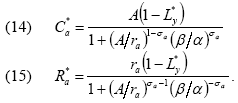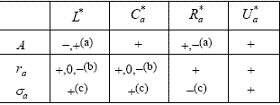This section sets out the model for explaining the well-being paradox. The arguments in Section 3 drawn from a large amount of literature are here distilled in formal analysis. Clear-cut assumptions will be made to concentrate on differences, e.g. relational goods versus market goods, or ‘secure’ versus. ‘insecure’ people.
Nevertheless, the model has a substantial structure, and it is able to determinate prediction. The presentation of the model is divided among Section 4.1, where expectations and the utility function are assumed to be exogenous, Section 4.2, which introduces the personal disposition for relational goods, Section 4.3, which provides an explanation for the formation of expectations and for the change in the utility function, and Section 4.4, which is devoted to aggregation and overall dynamics.
Young people and adults, market and relational goods
Let us assume that the population of the economy is constant, and that at the beginning of each period, which discretely marks the time flow, births and deaths are the same in number. The life cycle of each individual is divided into two periods: ‘youth’, when the individual does not work, and ‘adulthood’, when s/he works for a labour income. Hence, if the size of population is N, on moving from one period to the next, the number of births, of passages from youth to adulthood, and of deaths is 0.5N.
Each household consists of an adult and a youth; both of them can consume two goods with partially specific preferences. The first good is the only proper good produced by the economy, which will be called ‘market good’. The second one is called ‘relational good’, and it has been previously discussed. The two goods may be complementary or substitutes. Adults spend their labour income on their own consumption, and on consumption by the youth. During non-labour time they enjoy close personal relationships with a number of other people of all ages. Youths split their time between consuming the market good and enjoying relationships.
Formally, the utility function of the youth, which explains his/her well-being (U), is of the usual Ces-type:

where C is the market good, R is the relational good. The subscript y refers the attached symbol to the youth. The generic i-th individual is implicitly referred to when not otherwise stated. The youth’s spending of time is described thus:

where the unitary endowment of time is spent in consuming the market good (ly), and enjoying personal relations (Hy). Note that the two activities are complementary ( σy <1). The two coefficients b and r are the consumption of the two goods per time unit respectively, and are taken to be exogenous in this section. In particular, r will be explained in the next section. The adult’s utility function has been kept similar to the youth’s,[24] i.e.:

where the subscript a denotes the adult, and where:

Households earn only labour income, and consume, so that the budget constraint is:
(7) Ca + Cy ≤ w
where w is the wage rate per adult in the competitive labour market. The adult spends his/her time working and consuming (L), and enjoying personal relationships (Ha), so that:
(8) L + Ha = 1
On the production side, the model is very simple, since the production function for the market good is in labour only, and with constant returns, so that:
(9) Ca = A La A>0
(10) Cy = A Ly
where La and Ly are the necessary labour performed by the adult to provide consumption for him/herself and for the youth respectively. Therefore:
(11) L = La + Ly
This model can be viewed as an extension of the textbook model of labour/leisure choice, so that its conclusions can be contrasted accordingly. In the textbook labour/leisure model, technical progress, which allows wages to grow, has two notable effects: it yields greater consumption and greater overall utility for each individual; it also yields greater leisure (less labour input) if consumption and leisure are complementary. Income is thus a good proxy for well-being, since consumption and overall utility are positively correlated. However, the reduction in labour input is not a stylised fact (see Section 1).
Therefore, complementarity between consumption and leisure is not a safe assumption. The model in this section yields only slightly different conclusions, but it provides the necessary framework and qualifications for the following sections. It will first solved for the youth, then for the adult, while study of the effects of technical progress and some comparative analysis will conclude the section Utility maximisation for the youth yields (the star stands for the solution value):

The youth’s consumption requires  labour from the adult. This enters the time
constraint for the adult’s maximisation, so that:
labour from the adult. This enters the time
constraint for the adult’s maximisation, so that:

To study technical progress, let us represent it as a greater value of A, i.e. labour productivity per time unit worked, through successive periods, and let us assume that b=A. This means that technical progress allows the youth to benefit more from a given quantity of market goods. This induces her/him to demand more market goods (eq. 12), but it also allows her/him to benefit from more relational goods (eq. 13), given that the two types of goods are complementary. The effects of technical progress for the adult are less straightforward, since the indirect effects through the youth’s utility must be considered.
The first row of Table 1 exhibits the sign of the effects on the relevant variables.[25] The results appear as expected, insofar as technical progress positively affect * C*a and U *a , and the effect on L* and on R *a depends on the elasticity of substitution between market and relational goods. The induced reduction in the labour required for the youth’s consumption strengthens the effects on C*a and on U *a , and makes the threshold value for σa, which divides the opposite signs of the effect, greater than 1.
Table 1. Relationships between selected parameters and adults’ labour, consumption, and utility.

Notes: (a) if σa ≤ 1 and σa>>1 respectively, (b) if σa<1, σa=1, and σa>1 respectively, (c) if β/ α <A/ra
Therefore, technical progress is beneficial for successive generations of both youths and adults, while the elasticity of substitution between the two goods is crucial to account for the positive or negative changes of labour and relational goods from one generation to the next. To clarify the role of the relational good and of the elasticity of substitution in the solutions, some comparative statics exercises considering ra and σa follow. The sign of the relationships between these parameters and the solutions are shown in the other two rows of Table 1.
The results for ra are analogous to those for A. Perhaps more unexpectedly, σa is not only positively related to utility, but it is also positively related to consumption and labour, and negatively to relational goods if β/ α<A/ra. The latter restriction will be assumed throughout the paper, since A tends to rise without bounds, while ra.will be studied as decreasing toward zero. The various rows of Table 1 should be interpreted differently. Whereas A increases for all individuals through successive periods, ra and σa will assume the same starting values for each generation of youth, and they change on passing to adulthood.
24 The adult’s utility function does not comprise the benefit of having the child in order to avoid the complication of choice analysis on this account, although some discussion will made of it below.
25 The derivations of the results of Table 1 can be requested from the author.
By Prof. Maurizio Pugno
Next: The experienced quality of the relational good, and personal disposition
Summary: Index